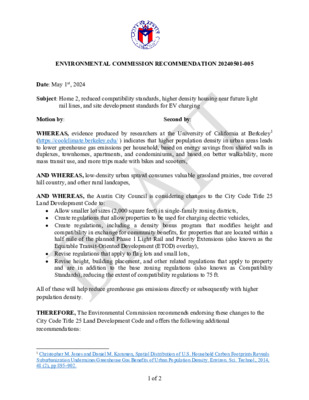20240501-005: Home 2 Reduced Compatibility Standards ETOD and EV charging DRAFT recommendation — original pdf
Backup

ENVIRONMENTAL COMMISSION RECOMMENDATION 20240501-005 Date: May 1st, 2024 Subject: Home 2, reduced compatibility standards, higher density housing near future light rail lines, and site development standards for EV charging Motion by: Second by: WHEREAS, evidence produced by researchers at the University of California at Berkeley1 (https://coolclimate.berkeley.edu/ ) indicates that higher population density in urban areas leads to lower greenhouse gas emissions per household, based on energy savings from shared walls in duplexes, townhomes, apartments, and condominiums, and based on better walkability, more mass transit use, and more trips made with bikes and scooters, AND WHEREAS, low-density urban sprawl consumes valuable grassland prairies, tree covered hill country, and other rural landcapes, AND WHEREAS, the Austin City Council is considering changes to the City Code Title 25 Land Development Code to: • Allow smaller lot sizes (2,000 square feet) in single-family zoning districts, • Create regulations that allow properties to be used for charging electric vehicles, • Create regulations, including a density bonus program that modifies height and compatibility in exchange for community benefits, for properties that are located within a half mile of the planned Phase 1 Light Rail and Priority Extensions (also known as the Equitable Transit-Oriented Development (ETOD) overlay), • Revise regulations that apply to flag lots and small lots, • Revise height, building placement, and other related regulations that apply to property and are in addition to the base zoning regulations (also known as Compatibility Standards), reducing the extent of compatibility regulations to 75 ft. All of these will help reduce greenhouse gas emissions directly or subsequently with higher population density. THEREFORE, The Environmental Commission recommends endorsing these changes to the City Code Title 25 Land Development Code and offers the following additional recommendations: 1 Christopher M. Jones and Daniel M. Kammen, Spatial Distribution of U.S. Household Carbon Footprints Reveals Suburbanization Undermines Greenhouse Gas Benefits of Urban Population Density. Environ. Sci. Technol., 2014, 48 (2), pp 895–902. 1 of 2 • Loosening development restrictions to allow denser housing could lead to the involuntary displacement of low-income renters, and the City should track this displacement and take steps to assist in relocating displaced tenants. If possible, the City should take steps to incentivize new higher density housing in high opportunity neighborhoods near jobs and existing mass transit. • • Over time, the City should track changes in transit use, micromobility use, walkability in new higher density developments to verify the predicted emission savings. Vote: For: Against: Abstain: Absent: Attest: 2 of 2